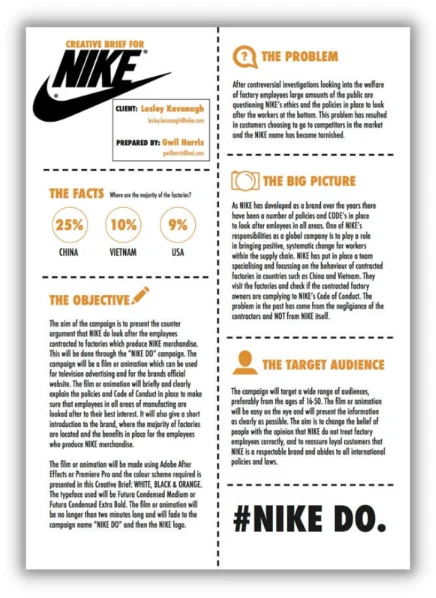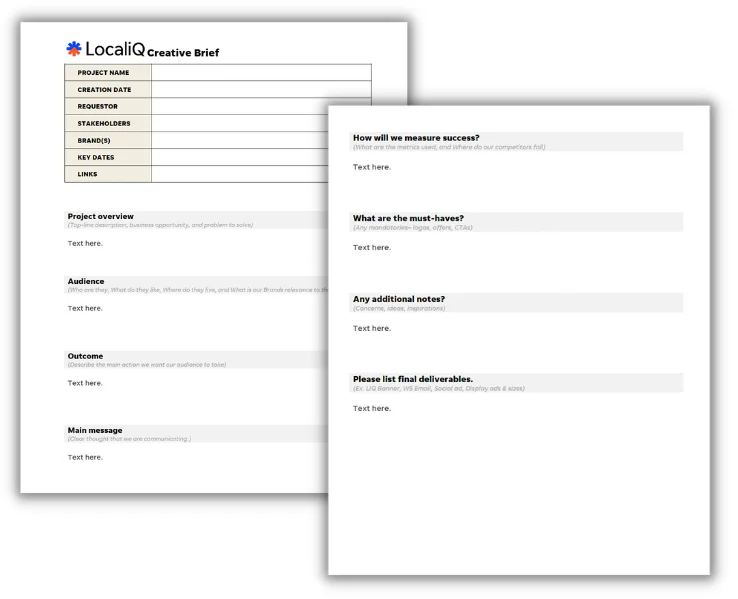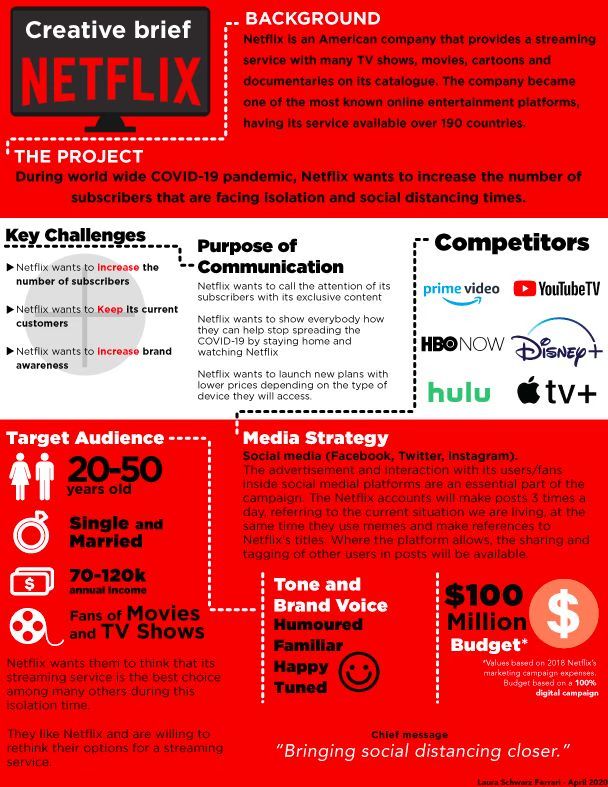
Have you often found yourself in a fairly typical household situation where you need to explain, preferably in simple words, exactly what another person needs to do?
Probably often. And you definitely understand how important it is to describe the task correctly and in detail so that the result is as expected and predictable as possible. It's the same in marketing! Writing a good creative brief is a difficult task, but it is extremely important to spend time on it and get it right. After all, it involves creating a step-by-step plan that describes in detail the goals, tasks, needs, features, and strategies that form the basis of the work of any creative team.
What begins the creation of a successful advertising campaign? It starts with a detailed analysis and plan of what needs to be done. If you work in a team with others, it also involves explaining the tasks that need to be completed to the executors.
In the modern rhythm of marketing development, the success of activities largely depends on the quality of communication and the consistency of results between all parties involved in the creative process. At the heart of any coordination is a document that reflects the way to achieve the desired results. This document can be a technical task, a creative task, or a marketing brief.
A lot depends on how well the brief is written. In fact, a well-thought-out creative task is the foundation on which all actions to create and launch effective advertising campaigns are based. It is a kind of compass that guides all members of the creative team, optimizing their actions and directing all efforts in one direction—to achieve goals.
If a team is working on the project, it is a file that combines efforts and provides the right development vector. And if you work independently, can the brief be waived? Of course not. Even if you create a technical task for yourself, it will help you stay focused on the main goal, move according to the given plan, and avoid making changes in the process (which may lead to a change in the marketing strategy).
So why is a creative brief important?
In digital activities, where campaigns deploy activities on various platforms and communication channels, the creative brief plays a key role in ensuring clarity, cohesion, and effectiveness. Its main purpose is to provide a single vision for all stakeholders involved in the development of marketing campaigns, including the client, agency, performers, and creative teams.
Vision alignment is important at every stage:
By aligning the vision of the client, agency, and creative team, a creative brief fosters collaboration, mitigates misunderstandings, and ensures that everyone is working toward a common goal. It serves as a guide, helping stakeholders stay on the same path and maintain consistency across interaction points.
At its core, a creative brief acts as a unifying force, synergizing diverse perspectives and resources to achieve the common goal of running a successful digital advertising campaign.
Who should develop the brief? Everyone! Essentially, you need to create these documents for any marketing project that requires creative development and coordination between multiple stakeholders.
Here are some common types of marketing activities for which you need to prepare a creative task before starting work:
This is a rather extensive, but far from exhaustive list. If you need to involve several people in a project (or stick to a single vector yourself), a creative brief is a must-have!
From theory to practice: What sections should a creative brief contain to provide complete and logically structured information from the customer to the performer? More details below.
The first thing that needs to be described is a concise general description of the project, which defines the essence of the task, the goal, the expected result, and the deadline. This, even a small delineation of boundaries, will avoid unnecessary tasks that expand the scope of work.
Everyone is probably familiar with the situation when the execution of one process automatically starts another, and everything starts to turn from the launch of an advertising campaign into the development of an advertising strategy. This is not correct and can lead to scope expansion, team burnout, and misalignment of resources to the overall goal.
However, contractors are not the only ones who can suffer from a poor-quality brief. The customer can also find themselves in a situation where there will be no end to the approvals, which will increase the time of independent participation in the project. Then, the expansion of requirements beyond the brief may cause conflict situations. Therefore, it is important to outline the future list of tasks in great detail and factually.
Therefore, a short description is necessary; it should be very clear and concise. Then you can expand the document and form the next section.
Understanding your brand's target audience is key to developing effective campaigns that achieve the results you want.
What information is needed?
At least:
We highly recommend delving into the psychographic profiles of your target audience in detail, such as their interests, values, lifestyle, and needs. Understanding motivation and behavior enables the team to tailor messages that directly respond to real-world needs and wants.
Additionally, include data from any relevant market research or consumer information that shows the purchase decision path, CJM, or purchasing preferences of your target audience. This information provides valuable context for developing a compelling campaign strategy.
Overall, the goal of providing and analyzing all this data is to find a trigger that will motivate potential consumers. This trigger should match the campaign objectives and organically complement the marketing strategy.
Any creative campaign begins and ends with a product. After all, the expected result is sales, sales, and more sales.
In this section, we discuss:
Your task: map the current orientations of product brand perception.
It is always a combination of factors—price, quality, expectations, etc. Use existing customer records and surveys to better understand the product and its brand.
Don't forget about unique selling points (USPs)—the unique features, benefits, or value propositions that differentiate your product or service from the competition. Highlighting the USP helps to find the brand's place in the market and resonate with the target audience.
Based on preliminary data, it is possible to form theses for the key message of a digital advertising campaign. All texts should be concise, easy to remember, and align with the brand's positioning.
It is not necessary to replicate competitors, but it is essential to monitor their information space. It may not be an in-depth competitive analysis, but basic information about colleagues in the market should still be included in the creative brief.
What must be analyzed?
Understanding the competitive landscape informs creative strategies and helps ensure a campaign stands out in a crowded marketplace. When you understand the general trends of the industry, the next step becomes obvious: to be consistent or to stand out diametrically and radically. There are advantages and disadvantages to each option.
Now it is time to write the most creative task. All previous information should form the necessary background for finding optimal solutions.
What should you focus on?
Choose the desired tone and style
Take into account the individuality of the brand and the interest of the target audience. Regardless of which direction works best for you, defining the creative direction sets the aesthetic tone for the entire campaign.
Visual elements
In this section, describe all the requirements for visual and graphic elements that should be included in the campaign: photo or video, color palette, typography, and design motifs. Visuals play a crucial role in attracting attention and communicating brand messages effectively.
Don't forget to add any examples for inspiration. This will allow the creative team to feel your mood, emotions, and vibe to adapt it to the advertising campaign. If you have interesting examples from other companies (perhaps both direct competitors and colleagues in the industry) that inspire you, add them as well.
Even when time is not limited, it still needs to be managed. Because a task that has no deadlines cannot be called a task. The deadline and budget should be clearly and carefully specified in the brief.
About budget constraints
Provide limits for the digital advertising campaign, including the allocation of funds for creative creation, ad placement, and any other related costs. This ensures that the team can and wants to work within the specified budget parameters, and they are realistic.
Chart of results
It is very important! Set a timeline for key milestones and deliverables, including concept development, review, approval, development, and launch of digital campaigns. Without deadlines, the process can take forever!
Detailed timelines ensure smooth execution of project tasks, efficient management of resources, and a shared understanding by all stakeholders of when different parts of a single process will be completed.
Schedules can include points that indicate when the project has reached the appropriate stages of completion. For example: creative concept approval, design mock-up approval, prototype development, storyboarding, etc.
One key aspect that is often overlooked when calculating project timelines is both internal (agency) and external (client) reviews. It is important that sufficient time is allocated for these checks, as this is where delays often occur. Provide a roadmap for when the results will be completed and when key stakeholders need to review and provide their comments.
When all the data is described, the client and the creative team can agree on the direction and priority of efforts to develop an attractive and effective digital advertising campaign that resonates with the needs and expectations of the target audience and achieves the desired goals.
At BannerBoo, we've written and received hundreds of creative technical assignments, and we have something to say about their effectiveness. Let's go in order:
Be clear and concise
Use plain language and avoid slang or ambiguous terms that may confuse or misrepresent information. Clearly and concisely state the objectives, target audience, key message, and desired results of the campaign.
Provide specific details
Describe only relevant information and recommendations for the creative team. This should be a qualitative analysis, as it acts as a foundation for future advertising activities. The more precisely you describe the desired images, tone of voice, and stylistic preferences, the easier it will be for the creative team and the better the realization of the vision will be.
Write briefly
Brevity is the sister of talent. Focus only on important information that directly affects the success of the campaign. Avoid unnecessary details that can distract from the main objectives of the task.
Involve all key stakeholders
Drive communication by involving key stakeholders from the client team, agency, and creative department in the brief writing process. This ensures that everyone's perspectives and experiences are taken into account, resulting in a complete and effective briefing.
Receive and analyze comments and feedback
Encourage open communication and feedback throughout the brief writing process. Get input from both the client and the team to ensure the brief accurately reflects the client's goals and expectations and inspires everyone involved in the process.
Don't forget about iteration and improvement
Treat the brief as a living document that evolves as the campaign evolves. Be open to refining and analyzing the brief based on feedback and new ideas that emerge during the creative process.
Set a time frame for waiting for feedback
Especially deadlines for review and approval of ready-made solutions. This will help reduce the risk of delays and ensure that everyone is involved in the process from the start.
Maximize creativity and add innovation
Collaboration between the client and the creative team fosters a synergy of ideas that leads to more creative and innovative solutions. Working together, both parties can use their expertise to develop compelling campaign concepts.
Build trust and partnership
Collaboration fosters a sense of partnership and trust between the client and the creative team, laying the foundation for long-term success. When clients feel included and valued in the creative process, they are more likely to trust the agency's expertise and willingly invest in the success of their brand.
Effective collaboration and feedback are essential components of writing a successful creative brief. By fostering open communication, involving key stakeholders, and supplementing the brief as needed, you can ensure that the final document is clear, comprehensive, and meets goals and expectations.
Need some inspiration before writing your own creative brief?
Here are a few examples to help you orient yourself and create the structure you need.
Colgate

Colgate doesn't take the hard way, and that's always a good idea. Simple but effective.
Marketers have clearly laid out the information necessary to start working on their project. The design is also very laconic but branded, with several red Colgate badges.
Nike

Nike has great branding, so it stands to reason that their creative briefs are worthy examples as well. They clearly state their facts, purpose, problem, big picture, and their target audience to help the team understand and manage their project.
LocaliQ

Here's an example of a creative brief that the LocaliQ team uses for internal projects. The document includes all the necessary information needed to complete the tasks.
Netflix

A good example of a brief that covers all the necessary information, even in such a corporate style. All information is structured and divided into blocks that are very easy to read and understand. Even such a serious document can be modern and special.
Creating a clear creative brief is not just "because you have to"; it is an important step on the way to a successful digital advertising campaign. This document should contain all the necessary information for effective collaboration with clients, team, and other stakeholders.
Key facts to remember when writing a marketing brief for any task:
A well-crafted brief lays the foundation for success by guiding the creative process, minimizing risk, and maximizing effort to achieve results.
In today's digital environment, where competition for attention is fierce and audience expectations are high, the importance of strong creative writing cannot be overstated. This is the basis that strengthens creativity, innovation, and well-thought-out campaigns, giving a great response from the audience.
So, when starting your next digital advertising campaign, remember the importance of a creative brief. Take the time to create a document that not only describes the specifics of your campaign but also inspires creativity, fosters collaboration, and ultimately delivers results. Because when it comes to digital advertising success, a logical and thoughtful creative assignment can make all the difference.
A creative brief is a document that describes the objectives, target audience, key messages, creative direction, and other important details of a digital advertising campaign. It serves as a roadmap for the creative team to develop engaging and effective digital ads that resonate with their target audience and align with the prospect's motivations.
The three main sections of a creative task usually include:
background and objectives (providing context for the client's brand and outlining campaign objectives);
target audience (description of demographic and psychographic characteristics of potential customers);
creative brief (guidance on the desired tone, style, and visuals for the upcoming campaign).
When describing your target audience, it's important to include demographic information (age, gender, location, income level) as well as psychographic data: interests, values, lifestyle choices, and purchase motivations. Such a comprehensive understanding of the target audience helps to form effective messages and creative elements. And, of course, potential customers will better perceive, remember, and use the value proposition.
A creative brief is usually written jointly by representatives of the client's marketing team, the advertising agency, and other relevant stakeholders. The client's marketing manager or project manager can work on its creation, complemented by recommendations from the creative team responsible for the campaign.
First, it is concise and comprehensive, providing specific guidance and direction for the creative team.
Second, it aligns the client's goals with the brand's identity.
The brief should pinpoint the target audience, key messages, unique selling points, and desired creative elements, creating the basis for developing a successful digital advertising campaign.
Writing a creative brief is an important stage in creating digital campaigns. This document helps stakeholders understand the goals and expectations of the campaign, guides the creative team in the right direction of strategies and concepts, and serves as a reference for evaluating the success of the campaign. Ultimately, a thoughtful brief lays the foundation for implementing effective and results-driven digital marketing initiatives.